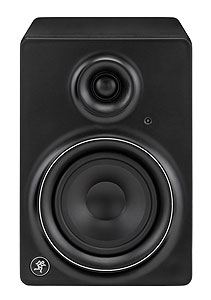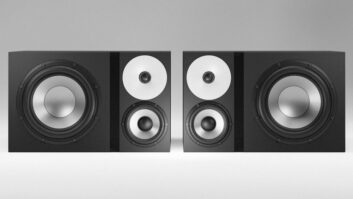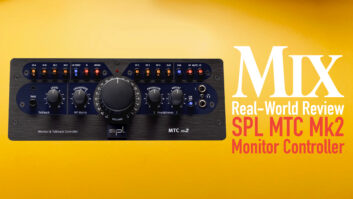
The Mackie MR5mk2’s diminutive size belies its huge sound.
Forget everything you might have known about the original Mackie MR5 studio monitor (introduced in 2008). The new MR5mk2 is a whole other ballgame. Among the many design changes, the updated two-way, bi-amplified monitor shows off an all-new silk-dome tweeter and polypropylene woofer. A revamped baffle and eye-catching waveguides contribute to improved imaging and depth. The bass response has been extended, and they can get louder, too, if you want. What’s more, the price has been chopped down to only $199.99 each (MSRP), making these impressive performers veritable trailblazers in their price range.
SMALL FOOTPRINT
The MR5mk2 tips the scale at a reassuring 14.3 pounds, fairly hefty for a monitor measuring only 11.5×7.8×10.6 (HxWxD) inches. The 1-inch tweeter is ferrofluid-cooled to reduce power compression and is driven by a neodymium magnet that diminishes distortion. The 5.25-inch woofer employs an inverted dust cap for smoother response. There’s nothing too unusual here except that each driver is ensconced in a molded waveguide with a moon-crater profile; the circular lip extends forward beyond the baffle, reducing diffraction that would otherwise compromise imaging. It looks très cool!

All corners and edges are rounded laterally, but not toward the front and back baffles. An elegant white LED on the front baffle lights when you apply power to the monitor. The power switch is located on the rear of the matte-black, 5/8-inch-thick MDF cabinet, along with an oval bass-reflex port, IEC power receptacle (for the detachable 6-foot AC cord) and a generous helping of input connectors and controls.
Balanced XLR and ¼-inch TRS connectors and unbalanced RCA jacks are provided for line-level input. (You should connect only one input at a time.) The TRS jacks can also accept unbalanced signals, making interfacing a snap.
The continuously variable input-attenuator control is designed to accept a +4dBu signal when set to full-clockwise position. This rotary control completely mutes the monitor when turned fully counterclockwise. The knob is detented only at the noon position. It’s very tiny (only ¼-inch in diameter) and its intermediate positions aren’t delineated with hash marks. That makes precise matching setups very difficult to achieve using anything other than the detented or maximum setting, especially in dim lighting conditions (as the knob is black).
Two three-way switches activate onboard shelving filters. The high-shelving filter has -2, 0 and +2dB settings and a 5kHz corner frequency, whereas the low-shelving filter offers a 2 or 4dB boost below 100 Hz or unchanged (0dB) response.

THE INSIDE STORY
The MR5mk2’s internally braced cabinet has open-cell foam inside to absorb internal reflections and help damp standing waves. It’s also magnetically shielded.
The woofer’s amplifier provides up to 55 watts of continuous power. The tweeter’s amp is rated at 30W continuous. Both amps are Class-A/B and provide active protection circuitry. While they are the same amps as those used in the original MR5, they’ve been re-voiced to match the mk2’s new drivers. The crossover frequency has been lowered to 3 kHz from 4 kHz in the original MR5.
The speakers have internal fuses to prevent damage from excessive levels, and the drivers’ amplifiers automatically and independently shut down if they get too hot. A highpass filter is situated before the woofer’s amplifier to prevent over-excursion; it provides 12dB/octave roll-off below 50 Hz. The resulting frequency response is 50-20k Hz, ±2 dB—phenomenal for such a small monitor. The maximum output level per pair is 116dB SPL at 1 meter—loud enough to dry your hair!
MONITORING THE SITUATION
I placed a pair of MR5mk2s on Primacoustic Recoil Stabilizers to decouple them from the shelves of my Omnirax Mixstation (console furniture with sidecar racks for outboard gear), upon which they were situated. Behind the monitors, an ASC Attack Wall (a modular array of tube traps) tightened up the impulse response in my tuned control room, which is meticulously treated with additional acoustic products.
I listened to a variety of country, folk, alternative and pop-rock mixes that I was intimately familiar with. With all its built-in filters nulled, I was instantly impressed by the sound of Mackie’s new monitors. The MR5mk2 doesn’t strive to be a proxy for a consumer playback system by providing a window into the midrange band like the Yamaha NS-10M and Avantone MixCube, for example. Instead, it aspires to produce the more full-bandwidth and balanced sound expected from much larger monitors. And it mostly succeeds. Reproduction in the upper-bass range was slightly exaggerated and flabby (probably due to the ported design), but much less so than with most other near-fields I’ve heard mounted on shelves. That deviation aside, these monitors sounded fantastic—so good, in fact, that one could consider using them as a main reference with the addition of a carefully matched subwoofer. Listening to one of my mixes, a sampled sine-wave bass disappeared when playing a low F note (44 Hz) but was clearly heard and in good balance on a higher B-flat (58 Hz).
Imaging, depth and transient response were all outstanding. I was very impressed with how detailed—yet sweet and smooth—the high-frequency range sounded. These monitors won’t fatigue your ears during long sessions unless you crank ’em up.
I wish the low-shelving filter could cut bass response. The monitors already put out plenty of mid-bass with their filters nulled and cabinets acoustically decoupled. I can imagine that suboptimal placement near a wall or corner would push the bass balance out of whack without an attenuating filter. Some users may also bemoan that the XLR connectors don’t latch.
But give me a break! We’re talking monitors that sell for around $300 a pair on the street. I’ve never heard monitors that sound this good for such a miserly price. Throw in all the connectivity, built-in filters and protection circuitry, and it’s hard to reckon how Mackie can offer these babies for so little dough. Attention, bargain hunters looking for a big sound in a small package: The MR5mk2 should be first on your shopping list.
Mix
contributing editor Michael Cooper is the owner of Michael Cooper Recording in Sisters, Ore.

Click on the Product Summary box above to view the Mackie MR5mk2 product page.







